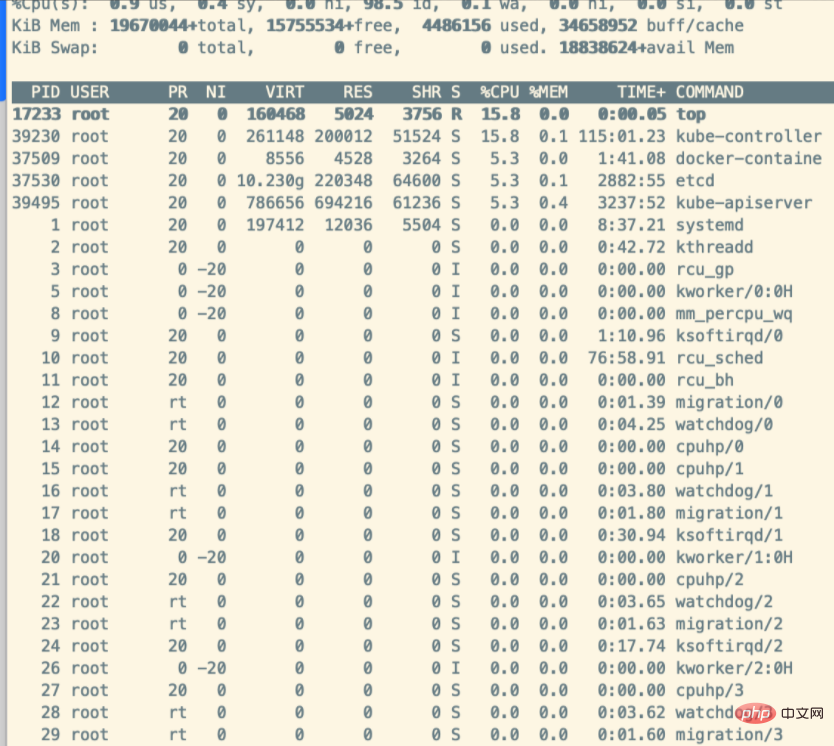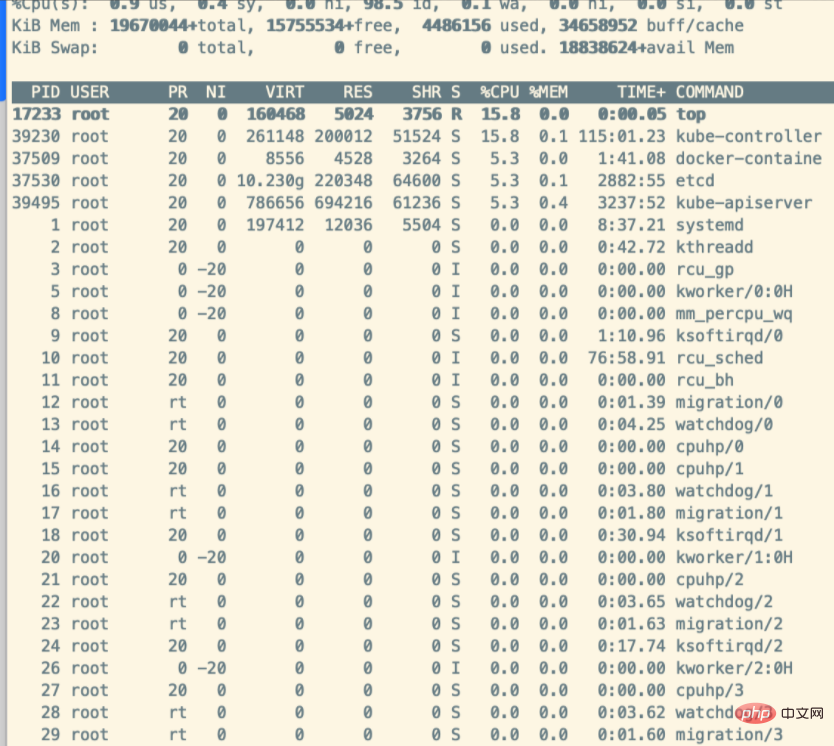What service is linux abrtd?
linux abrtd is a daemon that monitors application crashes; when a crash occurs, it will collect the crashed application and take actions based on the type of crash configuration in the abrt.conf config file, located in "/etc /abrt" directory has its configuration "abrt.conf" and so on.

#The operating environment of this tutorial: linux5.9.8 system, Dell G3 computer.
abrtd service is full of system resources?
##Problem Description
There is a process in our development environment that consumes particularly resources. Can you help analyze the reason? This has happened several times before on-site and in the public cloud. Eventually, this process will fill up the machine memory and cause downtime. Now I just discovered this problem at the scene
Solution ideas and methods
The first thing to do when the process is full is to take a look Process name, visual inspection is over, first time seeing top -pH 48297. Check which thread in the specific process has a problem and find that only one process has no thread
[root@yq01-kg-section1-bud3 libexec]# ps -ef | grep abrt-hook-ccpp root 45733 11797 0 12:18 pts/8 00:00:00 grep --color=auto abrt-hook-ccpp root 48297 2 99 Nov16 ? 15:42:50 /usr/libexec/abrt-hook-ccpp 11 0 8669 0 0 1605530067 e 8669 8669
abrtd
abrtd is a daemon process that monitors application crashes. When a crash occurs, it will collect the crash (core file command line, etc.)application, and take actions based on the type of crash and based on the configuration in the abrt.conf config file. There are various actions for the plug-in: for example, bugzilla reports crashes, transfers the report via ftp or reports or scp. Please check the corresponding plug-in in the manual page. abrtd: automatically bug report daemon. Automatic bug report daemon
The most painful thing about Linux debugging program is that the program crashes abnormally, but the core file cannot be found, which is very difficult Positioning problem. But with the core file, it is much easier to locate.
vi /etc/abrt/abrt-action-save-package-data.conf # With this option set to "yes", # only crashes in signed packages will be analyzed. # the list of public keys used to check the signature is # in the file gpg_keys # OpenGPGCheck = no # Blacklisted packages # BlackList = nspluginwrapper, valgrind, strace, mono-core # Process crashes in executables which do not belong to any package? # ProcessUnpackaged = yes # Blacklisted executable paths (shell patterns) # BlackListedPaths = /usr/share/doc/, /example*, /usr/bin/nspluginviewer, /usr/lib/xulrunner-*/plugin-container 还可以调整core文件的大小: [root@xx-host2 abrt]# cat abrt.conf # Enable this if you want abrtd to auto-unpack crashdump tarballs which appear # in this directory (for example, uploaded via ftp, scp etc). # Note: you must ensure that whatever directory you specify here exists # and is writable for abrtd. abrtd will not create it automatically. # #WatchCrashdumpArchiveDir = /var/spool/abrt-upload # Max size for crash storage [MiB] or 0 for unlimited # MaxCrashReportsSize = 1000 # Specify where you want to store coredumps and all files which are needed for # reporting. (default:/var/spool/abrt) # # Changing dump location could cause problems with SELinux. See man abrt_selinux(8). # #DumpLocation = /var/spool/abrt # If you want to automatically clean the upload directory you have to tweak the # selinux policy. # DeleteUploaded = no
systemctl stop abrt-ccpp.service
systemctl disable abrt-ccpp.service
systemctl status abrt-ccpp.service
Because the ccpp file cannot be created
sed -i 's/ProcessUnpackaged = no/ProcessUnpackaged = yes/g' /etc/abrt/abrt-action-save-package-data.conf&& service abrtd restart
Nov 17 13:15:15 yq01-kg-section1-bud3 abrtd: Lock file '.lock' is locked by process 48297 Nov 17 13:15:15 yq01-kg-section1-bud3 abrtd: Lock file '.lock' is locked by process 48297 Nov 17 13:15:16 yq01-kg-section1-bud3 abrtd: Lock file '.lock' is locked by process 48297 Nov 17 13:15:16 yq01-kg-section1-bud3 abrtd: Lock file '.lock' is locked by process 48297 Nov 17 13:15:17 yq01-kg-section1-bud3 abrtd: Lock file '.lock' is locked by process 48297 Nov 17 13:15:17 yq01-kg-section1-bud3 systemd: abrtd.service stop-sigterm timed out. Killing. Nov 17 13:15:17 yq01-kg-section1-bud3 systemd: abrtd.service: main process exited, code=killed, status=9/KILL Nov 17 13:15:17 yq01-kg-section1-bud3 systemd: Unit abrtd.service entered failed state. Nov 17 13:15:17 yq01-kg-section1-bud3 systemd: abrtd.service failed. Nov 17 13:15:17 yq01-kg-section1-bud3 abrtd: Lock file '.lock' is locked by process 48297
kill -9 48297
Check the service status

linux video tutorial"
The above is the detailed content of What service is linux abrtd?. For more information, please follow other related articles on the PHP Chinese website!

Hot AI Tools

Undresser.AI Undress
AI-powered app for creating realistic nude photos

AI Clothes Remover
Online AI tool for removing clothes from photos.

Undress AI Tool
Undress images for free

Clothoff.io
AI clothes remover

Video Face Swap
Swap faces in any video effortlessly with our completely free AI face swap tool!

Hot Article

Hot Tools

Notepad++7.3.1
Easy-to-use and free code editor

SublimeText3 Chinese version
Chinese version, very easy to use

Zend Studio 13.0.1
Powerful PHP integrated development environment

Dreamweaver CS6
Visual web development tools

SublimeText3 Mac version
God-level code editing software (SublimeText3)

Hot Topics
 1387
1387
 52
52
 How to use docker desktop
Apr 15, 2025 am 11:45 AM
How to use docker desktop
Apr 15, 2025 am 11:45 AM
How to use Docker Desktop? Docker Desktop is a tool for running Docker containers on local machines. The steps to use include: 1. Install Docker Desktop; 2. Start Docker Desktop; 3. Create Docker image (using Dockerfile); 4. Build Docker image (using docker build); 5. Run Docker container (using docker run).
 How to view the docker process
Apr 15, 2025 am 11:48 AM
How to view the docker process
Apr 15, 2025 am 11:48 AM
Docker process viewing method: 1. Docker CLI command: docker ps; 2. Systemd CLI command: systemctl status docker; 3. Docker Compose CLI command: docker-compose ps; 4. Process Explorer (Windows); 5. /proc directory (Linux).
 What to do if the docker image fails
Apr 15, 2025 am 11:21 AM
What to do if the docker image fails
Apr 15, 2025 am 11:21 AM
Troubleshooting steps for failed Docker image build: Check Dockerfile syntax and dependency version. Check if the build context contains the required source code and dependencies. View the build log for error details. Use the --target option to build a hierarchical phase to identify failure points. Make sure to use the latest version of Docker engine. Build the image with --t [image-name]:debug mode to debug the problem. Check disk space and make sure it is sufficient. Disable SELinux to prevent interference with the build process. Ask community platforms for help, provide Dockerfiles and build log descriptions for more specific suggestions.
 What computer configuration is required for vscode
Apr 15, 2025 pm 09:48 PM
What computer configuration is required for vscode
Apr 15, 2025 pm 09:48 PM
VS Code system requirements: Operating system: Windows 10 and above, macOS 10.12 and above, Linux distribution processor: minimum 1.6 GHz, recommended 2.0 GHz and above memory: minimum 512 MB, recommended 4 GB and above storage space: minimum 250 MB, recommended 1 GB and above other requirements: stable network connection, Xorg/Wayland (Linux)
 vscode cannot install extension
Apr 15, 2025 pm 07:18 PM
vscode cannot install extension
Apr 15, 2025 pm 07:18 PM
The reasons for the installation of VS Code extensions may be: network instability, insufficient permissions, system compatibility issues, VS Code version is too old, antivirus software or firewall interference. By checking network connections, permissions, log files, updating VS Code, disabling security software, and restarting VS Code or computers, you can gradually troubleshoot and resolve issues.
 Can vscode be used for mac
Apr 15, 2025 pm 07:36 PM
Can vscode be used for mac
Apr 15, 2025 pm 07:36 PM
VS Code is available on Mac. It has powerful extensions, Git integration, terminal and debugger, and also offers a wealth of setup options. However, for particularly large projects or highly professional development, VS Code may have performance or functional limitations.
 What is vscode What is vscode for?
Apr 15, 2025 pm 06:45 PM
What is vscode What is vscode for?
Apr 15, 2025 pm 06:45 PM
VS Code is the full name Visual Studio Code, which is a free and open source cross-platform code editor and development environment developed by Microsoft. It supports a wide range of programming languages and provides syntax highlighting, code automatic completion, code snippets and smart prompts to improve development efficiency. Through a rich extension ecosystem, users can add extensions to specific needs and languages, such as debuggers, code formatting tools, and Git integrations. VS Code also includes an intuitive debugger that helps quickly find and resolve bugs in your code.
 How to back up vscode settings and extensions
Apr 15, 2025 pm 05:18 PM
How to back up vscode settings and extensions
Apr 15, 2025 pm 05:18 PM
How to back up VS Code configurations and extensions? Manually backup the settings file: Copy the key JSON files (settings.json, keybindings.json, extensions.json) to a safe location. Take advantage of VS Code synchronization: enable synchronization with your GitHub account to automatically back up all relevant settings and extensions. Use third-party tools: Back up configurations with reliable tools and provide richer features such as version control and incremental backups.




